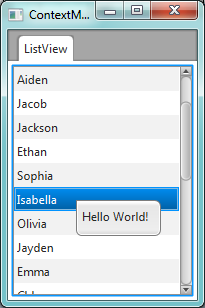FX Experience Has Gone Read-Only
I've been maintaining FX Experience for a really long time now, and I love hearing from people who enjoy my weekly links roundup. One thing I've noticed recently is that maintaining two sites (FX Experience and JonathanGiles.net) takes more time than ideal, and splits the audience up. Therefore, FX Experience will become read-only for new blog posts, but weekly posts will continue to be published on JonathanGiles.net. If you follow @FXExperience on Twitter, I suggest you also follow @JonathanGiles. This is not the end - just a consolidation of my online presence to make my life a little easier!
tl;dr: Follow me on Twitter and check for the latest news on JonathanGiles.net.

by Jonathan Giles | Jun 3, 2012 | Interviews, Scenic View
Today I have an interview with Ander Ruiz, a developer I’ve been working with on an updated version of Scenic View that will be released next week. The one point I want to raise is that we want your feedback on new features to add to this application! Leave comments in the comments section below. For those of you unfamiliar with Scenic View, there is now a Scenic View page here at FX Experience which will be shortly updated with the new release, but the current release can also be downloaded.
Hi Ander. Could you please introduce yourself to everyone?
I’m a graduate of the Engineering School of Bilbao with a Bachelor degree in Telecomunications Engineering. I’ve been working as a software architect at Telvent on Java for embedded environments since 2002 with lots off hardware control, all kind of communications (serial ports, usb, network protocols …), and user interaction.
You’ve mentioned to me previously that you do a lot of work with JavaFX-based kiosks – can you provide mode detail about how you use JavaFX for kiosks?
Our old machines use HTML as their GUI, and an obsolete JNI Wrapper of Mozilla (1.7!!) called JRex for browsing the (there was no WebView at that time :-(). It was not bad, but definitively far from perfect. So in 2008 I started to search for a replacement, and after discounting Flex (which was being used for our server application) I chose JavaFX. Three years later we have an appealing framework to build our GUIs, that reduces our development costs and bugs. And with JavaFX 2.x you have provided me a way to migrate the old GUIs.
(more…)
by Jonathan Giles | May 28, 2012 | Links
Hi all! Sorry for the delayed post this week – I have just moved to a new house (just outside of Palmerston North, New Zealand), and didn’t have internet access. Now that things are starting to get back to normal (and my internet is thankfully restored), I’ve got a bunch of links for your reading pleasure. Enjoy! 🙂
- As per usual, new developer preview builds of JavaFX 2.2 and Scene Builder 1.0 have been released.
- Along with the updated developer preview builds, the documentation team has also released updated Scene Builder documentation.
- I wrote a post here at FX Experience regarding how to show context menus when using a custom cell factory in ListView/TreeView/TableView controls.
- Gregg Setzer has started an open source project to create native looks for JavaFX applications. He has started off by developing a Windows 8 CSS file. I would love to see more people join this project and develop a number of CSS files for various operating system releases. If you’re interested, Greg is watching the thread of this post for any comments.
- Anton Epple has posted a comparison between the Scenic View application released a few weeks ago and the NetBeans Graphical UI Debugger. I will note that Scenic View is about to see another release, with a huge number of features added including live editing, searching (class name, node id and property name), and much, much more. However, there are of course things that Scenic View will likely never do, including integrating with the source code, so there is certainly value in getting to know both tools.
- Gerrit Grunwald has blogged about using the new Canvas API in the JavaFX 2.2 developer preview builds.
- Jim Weaver has posted part two of his ‘Best Practices for JavaFX 2 Enterprise Applications‘ series.
- Carl Dea wrote part three of his JavaFX 2 game tutorial.
- Thierry Wasyl has put up part four and part five of his TweetWallFX blog series. These posts cover using the JavaFX charting API, and pulling the whole project together. He has also put up a screencast demonstrating some of the more recent features.
- Amol Hingmire has posted about JavaFX 2.x development using FXML.
- Zoran Pavlovic has two posts this week. Firstly, he introduces how to style JavaFX buttons using CSS, and secondly he introduces the JavaFX ListView control.
That’s all for another week. Again, sorry for the delay. See you all again next week! 🙂

by Jonathan Giles | May 20, 2012 | Controls, Tips n' Tricks
One question I see occasionally is people asking how to go about using prebuilt cell factories (such as those provided in the DataFX project run by Johan Vos and I, those sitting in the OpenJFX 2.2 repo in the javafx.scene.control.cell package, or just those that they have created internally), and also show a context menu when the user right clicks. More generally, the problem is that cell factories are blackboxes, and there is no support for chaining cell factories together (or even getting hold of the cells as they are being used).
The answer is quite simple: wrap the cell factory inside another cell factory, and set the ContextMenu on the wrapping cell. In other words, you would write code such as this (for ListView):
// The cell factory you actually want to use to render the cell
Callback<ListView<T>, ListCell<T> wrappedCellFactory = ...;
// The wrapping cell factory that will set the context menu onto the wrapped cell
Callback<ListView<T>, ListCell<T> cellFactory = new Callback<ListView<T>, ListCell<T>>() {
@Override public ListCell<T> call(ListView<T> listView) {
ListCell<T> cell = wrappedCellFactory == null ? new DefaultListCell<T>() : wrappedCellFactory.call(listView);
cell.setContextMenu(contextMenu);
return cell;
}
};
// Creating a ListView and setting the cell factory on it
ListView<T> listView = new ListView<T>();
listView.setCellFactory(cellFactory);
(more…)
by Jonathan Giles | May 20, 2012 | Links
Welcome to this weeks links roundup. I’ve got plenty of good JavaFX links this week, so enjoy! 🙂
- JavaFX 2.2 build 8, and Scene Builder 1.0 build 38 are now available for download for testing.
- If you’re new to Scene Builder, check out the developer preview of the ‘getting started with JavaFX Scene Builder‘.
- Eric Bruno has an article up on Dr. Dobbs about the Scene Builder application that was recently made available as a developer preview.
- Patrick Martin has been very busy working on a new tool called Data Explorer, or Dex for short. This tool allows for data import and visualisation, and looks like it has huge potential. Check out the link, if even just for the screenshots (many of which use external non-JavaFX libraries).
- Gerrit Grunwald has blogged about exporting content from Adobe Fireworks CS6, and using the content in JavaFX (by copying the provided SVG, and slightly modifying the provided CSS).
- For those that couldn’t attend Stephen Chin’s talks at JustJava Brazil, he has now posted the translated slide decks online for you to check out.
- Thierry Wasyl has put up part two and three of his posts on his TweetWallFX application. Part two covers the creation of the business objects and use of FXML and controller classes, whilst part three covers transitions and animations, as well as tips on using the FXMLLoader class.
- Anton Epple continues to refine his JavaFX pinball game, adding features such as ball tracking (that is, zooming in and translating the view to follow the ball around the screen) and custom pinball node renderers. He also demonstrates the improved NetBeans support for Scene Builder that is coming in NetBeans 7.2.
- Will Hoover has posted sample code to create dialogs in JavaFX.
- Thomas Bolz has posted an applet version of his SudokuFX application which you can play online.
- Mark Anro Silva has posted code online to show how easy it is to create a loading indicator in JavaFX.
Catch you again next week 🙂

by Jonathan Giles | May 13, 2012 | Links, Scenic View
Hi all. Sorry about the lack of a post last week – I just got back from JavaOne India and was overloaded with work which I had to catch up on. However, I was collecting links all last week as well, and there are now a heap of good links to read through this week! 🙂 Enjoy!
Scenic View Sneak-peak
Finally, here is the current, in-development version of Scenic View that I am working on with Ander Ruiz. I will release an updated version of Scenic View as soon as all the features are in place.

That’s that for another week. Catch you all next week 🙂






